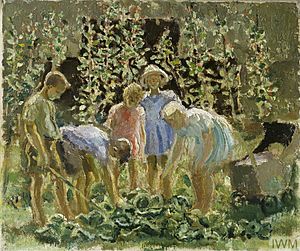Leila Faithfull facts for kids
Quick facts for kids
Leila Faithfull
|
|
|---|---|
| Born |
Leila Elizabeth Josephine Reynolds
12 April 1896 Woolton, England
|
| Died | 8 January 1994 (aged 97) Clifton, Bristol, England
|
| Nationality | British |
| Alma mater |
|
| Known for |
|
| Spouse(s) |
|
Leila Elizabeth Josephine Worsley (born Reynolds on April 12, 1896 – died January 8, 1994) was a talented British artist. She worked with many different art materials throughout her life. She is most famous for the amazing artworks she created during World War II, which showed what was happening in Britain at that time.
Leila Faithfull's Early Life and Art Training
Leila Faithfull was born on April 12, 1896, in Woolton, a town near Liverpool. Her father, Sir James Reynolds, had businesses there.
In 1919, she married George Faithfull. After he passed away, she married writer and critic Cuthbert Worsley in 1943.
Leila studied art at the Slade School of Fine Art in London during 1923 and 1924. After that, she traveled to Paris, France, to continue her studies at the Académie de la Grande Chaumière. In 1933, her art was shown at the Salon des Artistes Francais in Paris, which was a very important art exhibition.
Art During World War II
When World War II began, Leila Faithfull wanted to help. She applied to work for the War Artists' Advisory Committee (WAAC). This committee hired artists to create artworks about the war.
Even though WAAC did not hire her full-time, they gave her special permission and access to places. This allowed her to create paintings of important wartime scenes.
She painted children who had been evacuated from cities to safer areas. She also painted American soldiers playing baseball in a London park. The WAAC bought these paintings for their collection.
During the war, Leila also worked as a special artist at the Queen Victoria Hospital in East Grinstead. She worked in a new unit that focused on plastic surgery. Here, she created detailed drawings for surgical purposes, helping doctors with their work.
At the end of the war, Leila created a large artwork called a triptych. This painting showed the huge crowds celebrating outside Buckingham Palace on VE-Day. This day marked the end of the war in Europe.
After the War and Later Art
After World War II, Leila Faithfull became well-known for painting portraits of people. Her artworks were shown in many important galleries. These included the Royal Academy of Arts, the Royal Society of British Artists, and the New English Art Club.
Famous art collectors like Kenneth Clark and Sir Edward Marsh bought her paintings for their own collections.
In her later years, Leila started working with metal. She created sculptures of dancers and horses. Leila Faithfull passed away on January 8, 1994, at St. Angela's Convent in Clifton, Bristol, where she had lived for several years.


